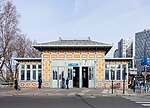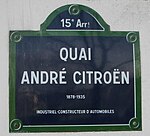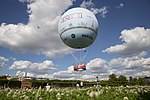Saint-Christophe-de-Javel, Paris
Roman Catholic churches in the 15th arrondissement of Paris

Saint-Christophe-de-Javel is a Roman-Catholic church located at 4 rue Saint-Christophe in the 15th arrondissement of Paris. It was constructed between 1926 and 1930 in the newly industralized neighborhood of Paris by the architect Charles-Henri Besnard (1881-1946), a follower of the architect and historian Viollet-le-Duc. While the church architecture is inspired by the Gothic architecture of the 13th century, it was constructed using a modern material, reinforced concrete, and made an innovative use of molded cement for the decoration of the facade and interior.
Excerpt from the Wikipedia article Saint-Christophe-de-Javel, Paris (License: CC BY-SA 3.0, Authors, Images).Saint-Christophe-de-Javel, Paris
Rue de la Convention, Paris 15th Arrondissement (Paris)
Geographical coordinates (GPS) Address Nearby Places Show on map
Geographical coordinates (GPS)
| Latitude | Longitude |
|---|---|
| N 48.84467 ° | E 2.27929 ° |
Address
Église Saint-Christophe de Javel
Rue de la Convention
75015 Paris, 15th Arrondissement (Paris)
Ile-de-France, France
Open on Google Maps









